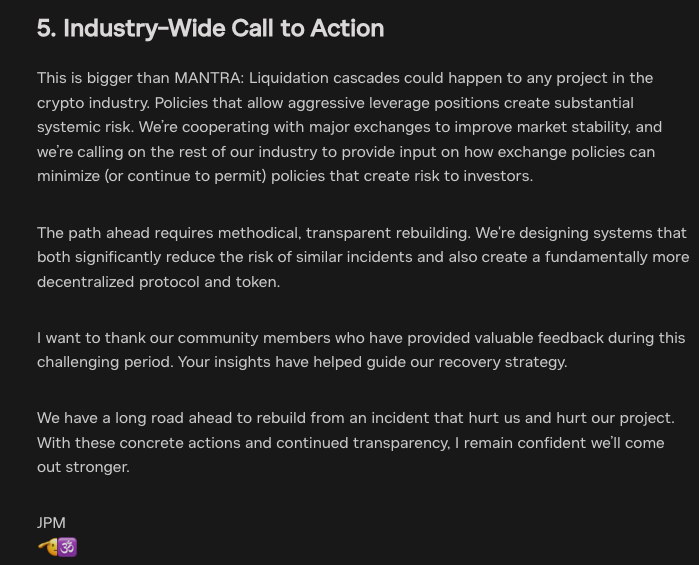- Mantra calls for DeFi reform, citing systemic leverage risks behind the OM token crash.
- Governance overhaul underway, including validator decentralization, token burn, and transparency tools.
- CEO urges shared accountability, warning similar crashes could hit other projects.
Decentralized finance (DeFi) platform Mantra calls for sweeping industry reforms in response to the recent collapse of its OM token, attributing the incident to systemic issues rather than isolated internal failures. In an update released on April 30, Mantra emphasized that the crash, which CEO John Mullin described as “bigger than Mantra,” should prompt crypto exchanges to reevaluate their leverage policies and work collectively to mitigate investor risks.
Mullin warned that ‘liquidation cascades could happen to any project in the crypto industry,’ which focused on the impact of high-risk leverage on the crypto market. This sentiment was echoed in Mantra’s tweet: ‘We’re working with the biggest exchanges to stabilize the markets and ask the entire industry to share on how exchange policies can reduce or continue to permit policies that risk investors.’

And it’s Mantra’s first detailed communication since the token started its dramatic plunge on April 13. It signalled a lack of action by the whole sector, with a particular emphasis on leveraged trading handled by centralized exchanges.
Mantra Commits to Validator Decentralization by 2025
The crash prompted Mantra to outline a series of measures aimed at governance and transparency that were part of its internal response to the crash. But a key item among them is a renewed push for decreasing the decentralization of validators. Since the platform started aiming for a significant reduction in internal validator use, they had a major commitment to reduce internal validators by half. They onboarded fifty total external partner validators by the end of Q2 2025.
The update also revealed that Mantra had burnt 150 million staked OM tokens off the circulation, reducing supply and returning faith to the investors. To be more transparent, Mantra has announced a real-time dashboard that gives the public access to tokenomics data. Meanwhile, to the technical resilience of the chain, the company has started testing the new Ethereum Virtual Machine-compatible testnet named “Omstead” through alpha testing.
While there has been a price collapse, Mantra has stressed that its blockchain infrastructure has continued to remain fully operational throughout the volatility they experienced with increases in transaction volumes to record highs.
Mullin Says OM Crash Reflects Industry Flaws
Mullin dismissed accusations that Mantra alone should be blamed and placed the incident in the context of flaws that could affect any project in today’s crypto market environment. “Reasons why these are ok to do on exchanges, but we should call it out that it serves as an additional risk to all projects in the industry and something we should be talking about as an industry,” he said.
According to Mantra, it has not tied any specific exchanges to the OM token liquidations—only online speculation, such as on Twitter, has done so. Given this, a user urged, in a popular comment on social media platform X, that “OKX must guarantee that a liquidation cascade can never happen again.”
However, Mantra’s ongoing demands for an open industry-wide dialogue and accountability have gained little traction from the country’s largest trading platforms. According to the company, unless the fragmented state of the decentralized finance space changes, such crashes continue to place the projects at risk.














